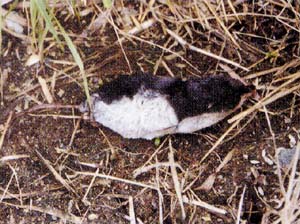Mammal Group
The water shrew Neomys fodiens is one of four British shrew species, the others being the common, pigmy and white-toothed. The water shrew is very distinctive, being the largest of the British shrews; it measures 110mm to 170mm and weighs 12g to 18g. Its coat is black on top, often with a small tuft of white on the ears and around its eyes, and silvery grey to white underneath. The tail is dark brown above and white below.
As the name suggests, it is strongly aquatic, being found mainly on the banks of clear, fast-flowing, unpolluted rivers and streams, but it can also be found on ponds and drainage ditches especially where watercress grows. It lives in burrows in banks, excavated using its forefeet and teeth.
Water shrews forage on land and in water, having a varied diet including invertebrates, molluscs, fish, frogs and newts. A voracious predator, the water shrew will take prey considerably larger than itself, immobilising it with a powerful venom.
Water shrews are very poorly recorded, with only 14 records in Cornwall since 1990. Knowledge of their density and distribution is therefore also poor, and their population size is consequently hard to estimate. A new project with the Cornwall Mammal Group, organised by the Pennon Otters and Rivers Project team and sponsored by the Mammals Trust UK and the Environment Agency, aims to redress this situation.
The project aims to increase knowledge of water shrew distribution in Cornwall. This will be achieved by training volunteers to identify water shrews, locate suitable habitat and carry out surveys. Anyone interested in the water shrew project or the Cornwall Mammal Group should contact Dave Salmon on (01872) 245514. Dave Salmon
 Reptile
and Amphibian Group
Reptile
and Amphibian Group
You have to get up early in the morning - or look late in the afternoon - to survey reptiles at the height of summer. In April or May, and again in September, the sun is cooler so the snakes and lizards must bask for longer to reach their operating temperature - which greatly increases our chances of seeing them. During the warmest months they warm up very quickly, so our window of opportunity for seeing them is much smaller.
If reptile spotting is your aim, take a morning walk over heathland, rough grassland or dunes while the sun is still cool - or try again as it fades towards evening, when reptiles might be needing to top up their body temperature. Our group is looking for people who would like to learn some simple survey techniques and gather information which we urgently need to conserve these creatures. Please give me a call if you would like to help. Mark Nicholson
Illustration: Laura Crees
New projects ...
We have received funding from English Nature to carry out three exciting new conservation section projects:
At the end of last year, we employed Richard Marsh as Community Biodiversity Officer. Richard, who hails from the West Midlands, is working with local authorities to integrate biodiversity issues into their strategic planning work. He is also liaising with community groups across the county, providing them with support and guidance on nature conservation issues and developing biodiversity-aware projects; this is assuming that they can understand his rich Black Country accent! .
We are all aware of the major positive impact that the tourist industry has on Cornwall's economy. In turn, it is well recognised that Cornwall's rich natural environment plays a significant role in attracting visitors to our beautiful county. Our tourism and biodiversity project aims to make links between the needs of our wildlife and of our visitors and to identify areas in which the relationship between the two can be enhanced to our mutual benefit
A major cash boost from English Nature, along with funds from our Marine Appeal, have at long last enabled us to establish a substantial marine project. This is an area of work which the Trust has wanted to develop further for many years, so we are particularly pleased to get started on it now. The project, which will commence this summer, will involve many areas of work including marine survey, awareness raising and campaigning.
Victoria Whitehouse

A water shrew cat kill. Cats are the "best" recorders of this species. If your cat brings one in, please tell us! (Note distinct black back and white belly.) Photo: Kate Stokes